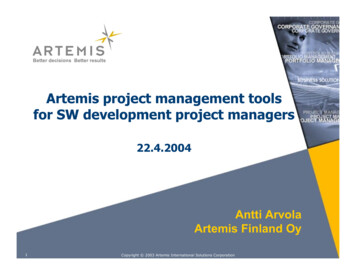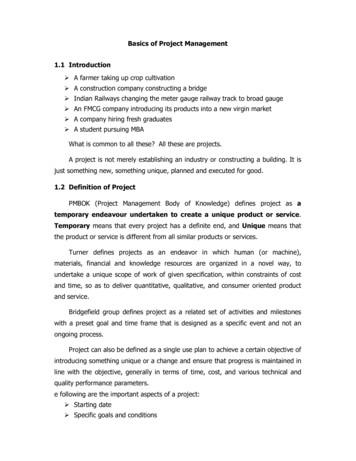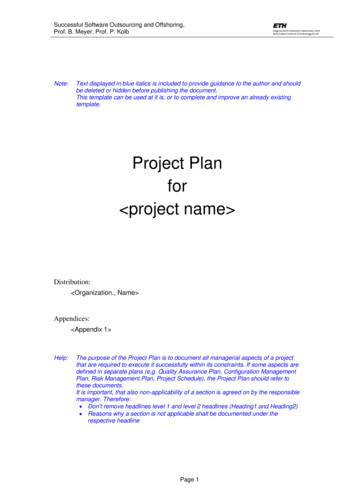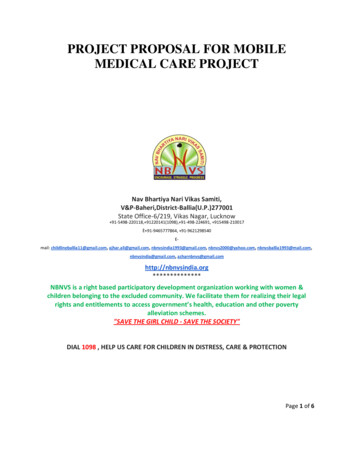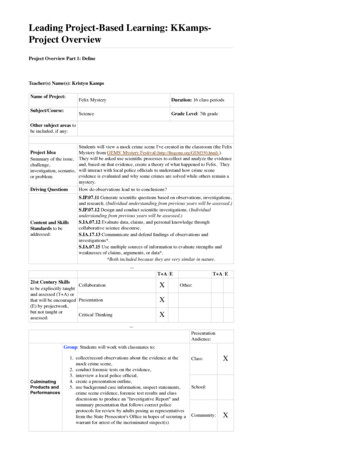
Transcription
An Introduction to ProjectManagement, Fifth EditionByKathy SchwalbeProfessor Emeritus, Augsburg CollegeDepartment of Business AdministrationMinneapolis, Minnesota
An Introduction toProject Management, Fifth EditionCover Photo: Dan Schwalbe 2015 Schwalbe PublishingISBN-13: 978-1505212099ISBN-10: 150521209XALL RIGHTS RESERVED. No part of this work covered by the copyright hereon may bereproduced, transmitted, stored, or used in any form or by any means graphic, electronic, ormechanical, including but not limited to photocopying, recording, scanning, digitizing, taping,Web distribution, information networks, or information storage and retrieval systems, except aspermitted under Section 107 or 108 of the 1976 United States Copyright Act, without the priorwritten permission of the author.Materials from Kathy Schwalbe’s Information Technology Project Management, Sixth andSeventh Editions, are used with permission from Cengage Learning.Microsoft and the Office logo are either registered trademarks or trademarks of MicrosoftCorporation in the United States and/or other countries. All screenshots from Microsoftproducts are used with permission from Microsoft.Information and screenshots from MindView Business are used with permission fromMatchWare. Information and screenshots from Basecamp are used with permission fromBasecamp.Some of the product names and company names used in this book have been used foridentification purposes only and may be trademarks or registered trademarks of their respectivemanufacturers and sellers.This publication is a derivative work of A Guide to the Project Management Body of Knowledge(PMBOK Guide) – Fifth Edition, which is copyrighted material of and owned by, ProjectManagement Institute, Inc. (PMI), Copyright 2013. This publication has been developed andreproduced with the permission of PMI. Unauthorized reproduction of this material is strictlyprohibited. The derivative work is the copyrighted material of and owned by, SchwalbePublishing, Copyright 2015.PMI, PMP, CAPM, PgMP, PMI-RMP, PMI-ACP, PMI-SP, OPM3, and PMBOK are registeredmarks of the Project Management Institute, Inc.Published by Schwalbe Publishing in Minneapolis, MN, June 2015.Visit www. pmtexts.com or www.kathyschwalbe.com for more information on this andother books by Kathy Schwalbe.
For Dan, Anne, Bobby, and ScottMy husband and children continue to be my inspiration.
BRIEF TABLE OF CONTENTSChapter 1An Introduction to Project, Program, andPortfolio Management1Chapter 2Project, Program, and Portfolio Selection37Chapter 3Initiating Projects71Chapter 4Planning Projects, Part 1 (Project Integrationand Scope Management)109Chapter 5Planning Projects, Part 2 (Project Time and Cost 145Management)Chapter 6Planning Projects, Part II (Project Quality,Human Resource, Communications,Stakeholder, Risk, and ProcurementManagement)187Chapter 7Executing Projects238Chapter 8Monitoring and Controlling Projects295Chapter 9Closing Projects335Chapter 10Best Practices in Project Management360Appendix ABrief Guide to Microsoft Project 2013389Appendix BResources455Appendix CCase Studies468Glossary487Index496.
Copyright 2015 Schwalbe Publishing Chapter 1 – Introduction1Chapter 1An Introduction to Project,Program, and PortfolioManagementLEARNING OBJECTIVESAfter reading this chapter, you will be able to: Understand the growing need for better project, program, and portfoliomanagement Explain what a project is, provide examples of projects, list various attributes ofprojects, and describe project constraints Describe project management and discuss key elements of the project managementframework, including project stakeholders, the project management knowledgeareas, common tools and techniques, and project success factors Discuss the relationship between project, program, and portfolio management andtheir contributions to enterprise success Describe the project management profession, including suggested skills for project,program, and portfolio managers, the role of professional organizations like theProject Management Institute, the importance of certification and ethics, projectmanagement careers, and the growth of project and portfolio management software
Copyright 2015 Schwalbe Publishing Chapter 1 – Introduction2OPENING CASEDoug Milis, the Chief Executive Officer (CEO) of Global Construction, Inc., was summarizingannual corporate highlights to the board of directors. Like many other large construction companies,they had a very difficult year. They had to scale down operations and let some employees go. Whenone of the board members asked what he was most proud of that year, Doug thought for a fewseconds, and then replied,“Excellent question, Gabe. Honestly, I think the main reason we survived this year wasbecause we are truly a project-based organization. We have dramatically improved our ability toquickly select and implement projects that help our company succeed and cancel or redirect otherprojects. All of our projects align with our business strategies, and we have consistent processes inplace for getting things done. We can also respond quickly to market changes, unlike many of ourcompetitors. Marie Scott, our Director of the Project Management Office (PMO), has done anoutstanding job in making this happen. And believe me, it was not easy. It’s never easy to implementchanges across an entire company. But with this new capability to manage projects across theorganization, I am very confident that we will have continued success in years to come.”INTRODUCTIONMany people and organizations today have a new or renewed interest in project management.In the past, project management primarily focused on providing schedule and resource data totop management in just a few industries, such as the military and construction industries.Today’s project management involves much more, and people in every industry and everycountry manage projects. New technologies have become a significant factor in manybusinesses, and the use of interdisciplinary and global work teams has radically changed thework environment. The facts below demonstrate the significance of project management: The top skills employers look for in new college graduates are all related to projectmanagement. Verbal communications, often ranked at the top of the list, moved downto number four. These top skills are:othe ability to work in a team structureothe ability to make decisions and solve problemsothe ability to plan, organize and prioritize work.1 In 2013, the average salary for someone in the project management profession in U.S.dollars was 108,000 per year in the United States; 134,658 in Australia, (the highestpaid country); and 24,201 in Egypt (the lowest-paid country). These average salariesdo not include bonuses. Of the 11,150 people from the United States who respondedto PMI’s salary survey, 80% had the Project Management Professional (PMP)credential, and their salary was over 20% higher than those without it.2 Organizations waste 109 million for every 1 billion spent on projects, according toPMI’s Pulse of the Profession report. Exceling at project management definitelyaffects the bottom line.3
Copyright 2015 Schwalbe Publishing Chapter 1 – Introduction 3The U.S. spends 2.3 trillion on projects every year, and the world as a whole spendsnearly 10 trillion on projects of all kinds. Projects, therefore, account for about onefourth of the U.S. and the world’s gross domestic product.The Apprentice, a popular reality television show, portrays the important role projectmanagers play in business. Each week of the show, teams select a project manager tolead them in accomplishing that week’s project. The project manager is held partlyresponsible for the team's success or failure. Whether you are trying to make money byselling lemonade, running a golf tournament, or developing a new product, projectmanagers play a vital role to business success.Project management is also a vital skill for personal success. Managing a family budget,planning a wedding, remodeling a house, completing a college degree, and many otherpersonal projects can benefit from good project management.WHAT WENT WRONG?In 1995, the Standish Group published an often-quoted study entitled “CHAOS.” This prestigiousconsulting firm surveyed 365 information technology (IT) executive managers in the United Stateswho managed more than 8,380 IT application projects. As the title of the study suggests, the projectswere in a state of chaos. United States companies spent more than 250 billion each year in the early1990s on approximately 175,000 IT application development projects. Examples of these projectsincluded creating a new database for a state department of motor vehicles, developing a new systemfor car rental and hotel reservations, and implementing a client-server architecture for the bankingindustry. Their study reported that the overall success rate of IT projects was only 16.2 percent. Thesurveyors defined success as meeting project goals on time and on budget.The study also found that more than 31 percent of IT projects were canceled beforecompletion, costing U.S. companies and government agencies more than 81 billion. The authors ofthis study were adamant about the need for better project management in the IT industry. Theyexplained, “Software development projects are in chaos, and we can no longer imitate the threemonkeys—hear no failures, see no failures, speak no failures.” 4In a more recent study, PricewaterhouseCoopers surveyed 200 companies from 30 differentcountries about their project management maturity and found that over half of all projects failed.They also found that only 2.5 percent of corporations consistently met their targets for scope, time,and cost goals for all types of projects.5Although several researchers question the methodology of the CHAOS studies, theirpopularity has prompted organizations throughout the world to examine their practices inmanaging projects. Managers are recognizing that to be successful, they need to be conversantwith and use modern project management techniques. People from all types of disciplines—science, liberal arts, education, business, etc.—can benefit from basic project managementprinciples. Individuals are realizing that to remain competitive, they must develop skills toeffectively manage the professional and personal projects they undertake. They also realize thatmany of the concepts of project management, especially interpersonal skills, will help them asthey work with people on a day-to-day basis.
Copyright 2015 Schwalbe Publishing Chapter 1 – Introduction4Organizations claim that using project management provides advantages, such as: Better control of financial, physical, and human resources Improved customer relations Shorter development times Lower costs Higher quality and increased reliability Higher profit margins Improved productivity Better internal coordination Higher worker moraleIn addition to project management, organizations are embracing program and portfoliomanagement to address enterprise-level needs. This chapter introduces projects and projectmanagement, describes the differences between project, program, and portfolio management,discusses the role of the project, program, and portfolio manager, and provides importantbackground information on these growing professions.WHAT IS A PROJECT?To discuss project management, it is important to understand the concept of a project. Aproject is “a temporary endeavor undertaken to create a unique product, service, or result.”6Operations, on the other hand, is work done in organizations to sustain the business. Projectsare different from operations in that they end when their objectives have been reached or theproject has been terminated.Examples of ProjectsProjects can be large or small and involve one person or thousands of people. They can bedone in one day or take years to complete. Examples of projects include the following: A young couple hires a firm to design and build them a new house A retail store manager works with employees to display a new clothing line A college campus upgrades its technology infrastructure to provide wirelessInternet access A medical technology firm develops a device that connects to smart phone. A school implements new government standards for tracking student achievement A group of musicians starts a company to help children develop their musicaltalents A pharmaceutical company launches a new drug A television network develops a system to allow viewers to vote for contestantsand provide other feedback on programs The automobile industry develops standards for electric cars A government group develops a program to track child immunizations
Copyright 2015 Schwalbe Publishing Chapter 1 – Introduction5VIDEO HIGHLIGHTSThe Project Management Institute (PMI) recognizes outstanding performance in projectmanagement by announcing a Project of the Year award winner. Their Web site lists winnerssince 1989, and videos summarize the award-winning projects since 2009. You can watchvideos of several projects, such as the following: 2014: AP60 Phase 1 Project, Jonquiere, Quebec, Canada 2013: Adelaide Desalination Project Adelaide, Australia 2012: Umatilla Chemical Agent Disposal Facility Operations Phase, Hermiston, OregonUSAYou can also see how project management was used on much older projects. MarkKozak-Holland wrote a book in 2011 called “The History of Project Management.” Indescribing his book, the author states the following: “Think about the Giza Pyramid, theParthenon, the Colosseum, the Gothic Cathedrals of Medieval Europe, the great voyages ofexploration, the Taj Mahal, and the mega projects of the industrial revolutions. Was projectmanagement used on these projects? Were the concepts of project management evenunderstood? Can we connect modern and ancient project management?” A 5-minute videodoes an excellent job of showing how project
05.06.2015 · to PMI’s salary survey, 80% had the Project Management Professional (PMP) credential, and their salary was over 20% higher than those without it.2 Organizations waste 109 million for every 1 billion spent on projects, according to PMI’s Pulse of the Profession report. Exceling at project management definitely



